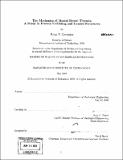| dc.contributor.advisor | Mary C. Boyce. | en_US |
| dc.contributor.author | Greviskes, Brian P | en_US |
| dc.contributor.other | Massachusetts Institute of Technology. Dept. of Mechanical Engineering. | en_US |
| dc.date.accessioned | 2010-01-07T20:53:42Z | |
| dc.date.available | 2010-01-07T20:53:42Z | |
| dc.date.copyright | 2009 | en_US |
| dc.date.issued | 2009 | en_US |
| dc.identifier.uri | http://hdl.handle.net/1721.1/50563 | |
| dc.description | Thesis (S.M.)--Massachusetts Institute of Technology, Dept. of Mechanical Engineering, 2009. | en_US |
| dc.description | Includes bibliographical references (leaves 196-198). | en_US |
| dc.description.abstract | Natural materials and structures have evolved over millions of years to perform very complex and specific biomechanical functions, and as a result can provide insight into optimal designs for particular properties. Mussel byssal threads, the attachment appendage of aquatic mus-sels, are one example of such structures. These threads protrude from the mussel, connecting the mussel to rocks and other hard surfaces, providing a strong and resilient, yet dissipative attachment (so that the mussel can remain attached to the rocks without being dashed against them during violent wave periods). The threads themselves are graded, with both the geometry (cross-section) and the mechanical properties transitioning from the proximal (proximal to the mussel) thread section, which is compliant and highly dissipative, to the distal thread section, which is stiff (relative to the proximal section) and less dissipative at low strains, but more dissipative at high strains. The goal of this thesis is to develop an understanding of the mechanical properties of the individual thread sections during the large stretches seen during its function, as well as to develop a microstructurally-informed constitutive model that captures the microstructural evolution of these materials with loading (an evolution that is dominated by protein unfolding). These material models will then be incorporated into three dimensional finite element model of the thread, in order to gain insight into the design of graded structures. | en_US |
| dc.description.abstract | (cont.) The constitutive model developed and outlined herein provides a method for modeling protein unfolding caused by mechanical loading, and captures the major characteristics of the mechanical behavior of these threads. The 3-D finite element model presented and discussed provides insight into design parameters for building graded structures. | en_US |
| dc.description.statementofresponsibility | by Brian P. Greviskes. | en_US |
| dc.format.extent | 198 leaves | en_US |
| dc.language.iso | eng | en_US |
| dc.publisher | Massachusetts Institute of Technology | en_US |
| dc.rights | M.I.T. theses are protected by
copyright. They may be viewed from this source for any purpose, but
reproduction or distribution in any format is prohibited without written
permission. See provided URL for inquiries about permission. | en_US |
| dc.rights.uri | http://dspace.mit.edu/handle/1721.1/7582 | en_US |
| dc.subject | Mechanical Engineering. | en_US |
| dc.title | The mechanics of mussel byssal threads : a study in protein unfolding and graded structures | en_US |
| dc.title.alternative | Study in protein unfolding and graded structures | en_US |
| dc.type | Thesis | en_US |
| dc.description.degree | S.M. | en_US |
| dc.contributor.department | Massachusetts Institute of Technology. Department of Mechanical Engineering | |
| dc.identifier.oclc | 463643083 | en_US |
